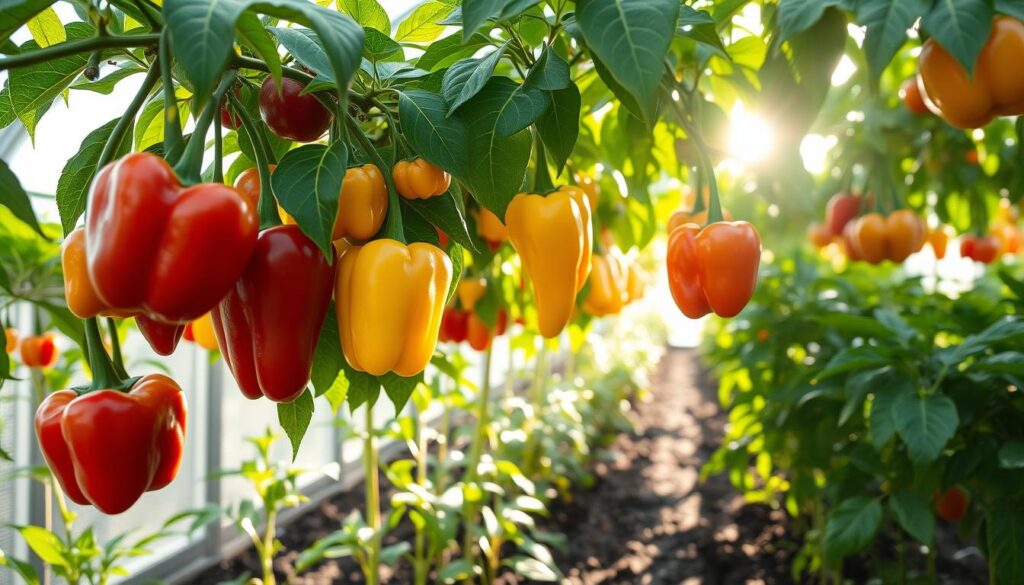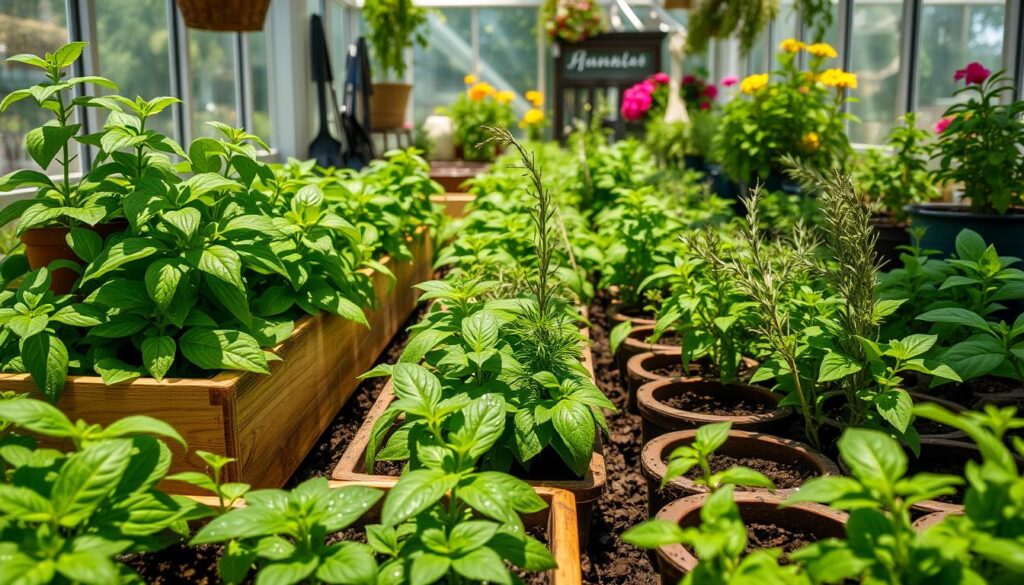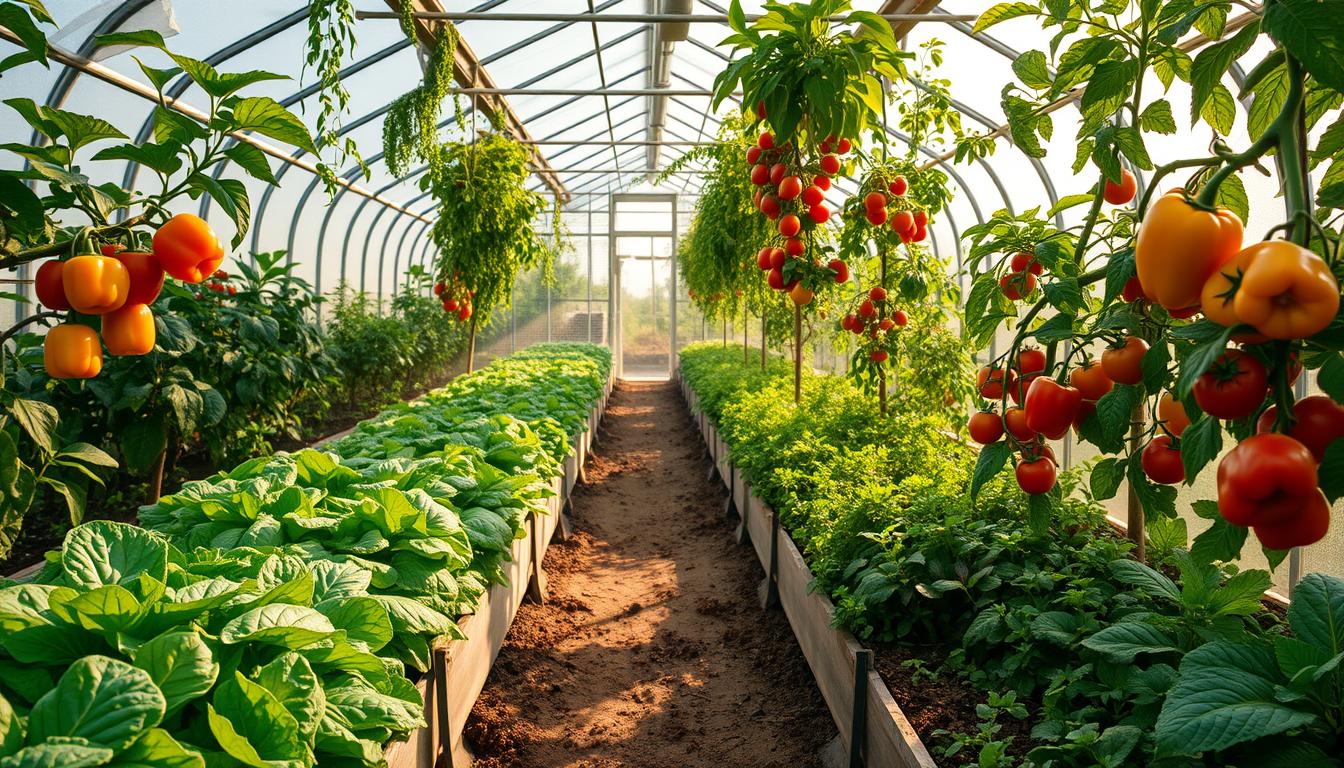I’m excited to share with you the best vegetables for greenhouses all year. This guide will help you create a lush and sustainable garden. You’ll learn how to pick the right vegetables and make your greenhouse perfect for growing. Soon, you’ll enjoy fresh produce from your garden all year long.
Key Takeaways
- Discover the top vegetables that excel in greenhouse cultivation for year-round production
- Learn the benefits of growing vegetables in a greenhouse and the factors to consider for successful greenhouse gardening
- Explore versatile and nutrient-dense vegetable options like tomatoes, leafy greens, cucumbers, bell peppers, and eggplants
- Understand the specific growing requirements and pest control strategies for each greenhouse vegetable
- Discover the joy of growing your own herbs in the greenhouse to add flavor and fragrance to your produce
Introduction to Year-Round Greenhouse Vegetable Cultivation
Greenhouse gardening lets you grow vegetables all year. It creates a safe space where you can grow many types of vegetables. This is because greenhouses protect plants from bad weather. You can enjoy growing vegetables in a greenhouse all the time.
Benefits of Growing Vegetables in a Greenhouse
There are many good things about growing vegetables in a greenhouse. Here are a few:
- Extended growing season: You can start plants early in spring and keep growing into winter.
- Precise climate control: You can set the temperature, humidity, and light just right for plants.
- Protection from pests and diseases: Greenhouses keep plants safe from pests and diseases outside.
- Increased yield and quality: You can grow more and better vegetables in a greenhouse than outside.
Factors to Consider for Successful Greenhouse Gardening
For successful greenhouse gardening, there are a few important things to think about:
- Temperature management: Keep the right temperature for your plants, using heat or sunlight.
- Lighting requirements: Make sure plants get enough light, whether from the sun or grow lights.
- Humidity and ventilation: Good air flow and humidity prevent diseases and help plants grow well.
- Nutrient management: Plan how to feed your plants well so they grow strong and healthy.
By focusing on these greenhouse growing factors, you can make the most of your greenhouse. This way, you can have fresh, tasty vegetables all year.
“Greenhouse gardening lets me grow vegetables all year. The control and protection of a greenhouse are amazing.”
The Best Vegetables to Grow in Greenhouses Year-Round
Greenhouses are perfect for growing vegetables all year. By picking the right varieties, gardeners can have a constant supply of fresh produce. Let’s explore some top choices for greenhouse gardening.
Tomatoes are a great choice for greenhouses. They love the stable climate, giving you tasty, healthy tomatoes all the time. Cucumbers also do well, thanks to the vertical space in greenhouses.
Leafy greens like lettuce, spinach, and kale are perfect for greenhouses. They grow fast and can be picked often. Bell peppers and eggplants add color and flavor to your dishes.
Root vegetables like carrots, radishes, and beets are also great. They grow well in greenhouses, providing fresh, crunchy produce all year.
Herbs like basil, thyme, and rosemary are essential in a greenhouse. They add freshness and variety to your cooking.
| Vegetable Type | Best Greenhouse Varieties | Key Benefits |
|---|---|---|
| Tomatoes | Cherry, Grape, Beefsteak | Consistent, high-yielding production, Excellent flavor |
| Cucumbers | Persian, English, Pickling | Thrive in greenhouse trellising, Crisp texture |
| Leafy Greens | Romaine, Kale, Spinach | Nutrient-dense, Fast-growing, Continuous harvests |
| Bell Peppers | Sweet, Snacking, Specialty | Vibrant colors, Unique flavors, Prolific yields |
| Eggplants | Classic, Asian, Fairy Tale | Heat-loving, Diverse culinary uses |
| Root Vegetables | Carrots, Radishes, Beets | Year-round harvests, Crunchy textures |
| Herbs | Basil, Thyme, Rosemary | Flavorful, Aromatic, Enhance culinary creations |
Choosing the right greenhouse vegetable varieties lets gardeners enjoy a year-round greenhouse vegetable harvest. This way, they can enjoy the best of greenhouse vegetables right in their own backyard.
Tomatoes: The Versatile Greenhouse Favorite
Greenhouse tomatoes are a gardener’s dream, providing a constant supply of juicy, tasty fruits. They love the stable temperature and humidity of greenhouses. With so many tomato varieties for greenhouses to choose from, each has its own special traits and benefits.
Choosing the Right Tomato Varieties
To grow great greenhouse tomatoes, pick the right types for indoor growing. Consider a few important things:
- Growth Habits: Go for determinate or semi-determinate tomatoes. They grow more neatly than indeterminate types, which can get too big for a greenhouse.
- Disease Resistance: Choose tomatoes that fight off common greenhouse diseases like powdery mildew and early blight. This helps your tomatoes stay healthy and productive.
- Flavor Profiles: Try different tomato flavors. From sweet heirlooms to tangy hybrids, find the ones you like best for your cooking.
By picking the right tomato varieties for greenhouses, you can make the most of your indoor space. Enjoy a constant supply of delicious tomatoes all year round.
| Tomato Variety | Growth Habit | Disease Resistance | Flavor Profile |
|---|---|---|---|
| Beefsteak | Indeterminate | Moderate | Juicy, Meaty |
| Cherry Tomato | Determinate | High | Sweet, Bite-sized |
| Heirloom | Indeterminate | Low | Unique, Flavorful |
| Hybrid | Semi-Determinate | High | Consistent, Reliable |
Leafy Greens: Nutrient-Dense and Easy to Grow
Leafy greens are a top choice for greenhouse gardening. They thrive in greenhouses and are super healthy. Growing them has changed my gardening game.
Leafy greens like kale, spinach, and Swiss chard are full of good stuff. They have vitamins, minerals, and antioxidants. By growing them in greenhouses, you get fresh, healthy food all year.
Another great thing about leafy greens in greenhouses is how easy they are to care for. They do well in the greenhouse’s controlled environment. This makes them perfect for new gardeners or those wanting to grow more without spending a lot of time.
- Kale: A nutrient powerhouse known for its high levels of vitamins A, C, and K, as well as its wealth of antioxidants.
- Spinach: Packed with iron, folate, and other essential nutrients, spinach is a versatile and easy-to-grow greenhouse green.
- Swiss Chard: Boasting a beautiful array of colors and a mild, earthy flavor, Swiss chard is a nutrient-dense addition to any greenhouse garden.
Adding different types of greenhouse leafy greens to your garden is a smart move. You’ll get a lot of healthy food and enjoy the benefits of greenhouse gardening.
“Leafy greens are the foundation of a healthy diet, and growing them in a greenhouse allows you to enjoy their fresh, nutrient-rich benefits all year long.”
Cucumbers: Perfect for Greenhouse Trellising
Greenhouse cucumbers are a great choice for indoor gardens. They grow well in a controlled space and can climb up trellises. This makes the most of your greenhouse area. By picking the right cucumber types and setting up good trellises, you can have a lot of cucumbers all year.
Controlling Pests and Diseases in Greenhouse Cucumbers
Greenhouse cucumbers have many benefits but can face pests and diseases. It’s important to watch for problems like powdery mildew and spider mites. Keeping your greenhouse clean and well-ventilated is key for greenhouse cucumber health.
| Cucumber Variety | Key Characteristics |
|---|---|
| Parthenocarpic Cucumbers | Able to set fruit without pollination, ideal for greenhouse growing |
| Gynoecious Cucumbers | Produce primarily female flowers, resulting in higher yields |
| Mini Cucumbers | Compact plants that are well-suited for greenhouse cultivation |
| Specialty Cucumbers | Unique shapes, colors, and flavors to add variety to your greenhouse |
| Standard Slicing Cucumbers | Reliable and versatile varieties that thrive in greenhouse conditions |
Choosing the right greenhouse cucumbers and setting up good cucumber trellising systems is key. Also, managing greenhouse cucumber pests and diseases well is important. With the right care, cucumbers can be a wonderful part of your indoor garden.
“Greenhouse cucumbers are a true delight, offering a year-round source of crisp, flavorful produce right at your fingertips.”
Bell Peppers: Colorful and Flavorful Greenhouse Crops
Bell peppers are a great choice for a thriving greenhouse garden. They add color and flavor to your harvest. We’ll look at the best bell pepper varieties for greenhouses and what they need to grow well.
Meeting the Specific Growing Requirements of Bell Peppers
Growing greenhouse bell peppers needs careful attention. They have special needs compared to other greenhouse crops. Here are key factors to ensure your bell peppers grow well:
- Temperature Control: Bell peppers like it warm, between 70-85°F during the day and 60-70°F at night. Keeping the temperature steady is important for growth and fruit.
- Humidity Management: They need moderate humidity, 50-70%. Good ventilation and humidity control help prevent diseases and promote growth.
- Nutrient-Rich Soil: Bell peppers love well-draining, nutrient-rich soil. Use a balanced fertilizer to meet their nitrogen, phosphorus, and potassium needs.
- Ample Sunlight: They need full sun, at least six hours a day. Make sure your greenhouse gets plenty of natural light.
By meeting these bell pepper greenhouse requirements, you can grow a lot of colorful and tasty bell peppers in your greenhouse.

Success in growing bell peppers in greenhouses comes from balancing environmental factors and plant needs. With the right care, you can have these vibrant vegetables all year.
Eggplants: Versatile and Heat-Loving
Greenhouse fans will love eggplants. They are versatile and love the heat. These purple veggies add flavor to any greenhouse garden all year.
Greenhouses are perfect for eggplants. They keep the temperature and humidity just right. Eggplants need warmth to grow well. This setup helps them grow big and strong all year.
Selecting the Right Eggplant Varieties
Choosing the right eggplant is key for a great greenhouse crop. Look for varieties that fit well in a greenhouse. Here are some tips:
- Compact growth habit: Choose eggplants that grow bushy. They fit better in a greenhouse.
- Early maturity: Pick eggplants that grow fast. This means more harvests.
- Disease resistance: Find eggplants that fight off common greenhouse diseases.
| Eggplant Variety | Growth Habit | Maturity Time | Disease Resistance |
|---|---|---|---|
| Black Beauty | Compact | 60-70 days | Good |
| Fairy Tale | Compact | 50-60 days | Excellent |
| Ichiban | Upright | 55-65 days | Average |
By picking the right eggplant varieties, you’ll enjoy a great harvest. These veggies are perfect for greenhouses.
Root Vegetables: Underground Gems for Year-Round Harvest
Many greenhouse gardeners miss out on the benefits of root vegetables. These hidden treasures can add a lot to your greenhouse garden. By picking the right varieties, you can have a constant supply of tasty and healthy root crops all year.
Choosing the Right Root Varieties for Greenhouse Growing
Not all root vegetables are good for greenhouses. To grow them well, think about a few key things:
- Growth habits: Pick varieties that don’t take up too much space.
- Maturity timelines: Mix early, mid, and late varieties for a longer harvest.
- Nutrient and water needs: Choose vegetables that need similar things to make caring for them easier.
Carrots, beets, radishes, and turnips are great choices for greenhouses. They give you fresh food and make your greenhouse look good too.
| Vegetable | Ideal Greenhouse Varieties | Maturity Timeline | Unique Growing Considerations |
|---|---|---|---|
| Carrots | Nantes, Danvers, Mini-carrots | 60-90 days | Prefer well-draining, loose soil |
| Beets | Chioggia, Golden, Cylindra | 45-60 days | Tolerate partial shade |
| Radishes | Cherry Belle, French Breakfast, Watermelon | 21-30 days | Grow quickly in cool conditions |
| Turnips | Tokyo Cross, Purple Top, Hakurei | 40-60 days | Adaptable to various soil types |
By picking the right root vegetables for your greenhouse, you can have fresh, healthy food all year. Even in the most controlled indoor spaces.
Herbs: Adding Flavor and Fragrance to Your Greenhouse
Herbs are essential for adding flavor and fragrance to your greenhouse. They include fragrant basil and earthy rosemary. These plants do well in greenhouses, offering a rich harvest for your cooking.
Preserving and Using Your Greenhouse-Grown Herbs
It’s key to have a plan for using your greenhouse herbs. Here are some tips to enjoy your greenhouse-grown herbs:
- Drying: Hang herbs or spread them on a baking sheet in a warm, well-ventilated area to dry.
- Freezing: Chop herbs and freeze them in ice cube trays with water or olive oil for soups and sauces.
- Pesto and Compound Butters: Blend herbs with nuts, garlic, and olive oil for pesto, or mix into softened butter for compound butters.
- Infused Oils and Vinegars: Steep herbs in oils or vinegars for tasty condiments and marinades.
Using these methods, you can keep your greenhouse-grown herbs fresh and versatile. This way, you can use greenhouse-grown herbs all year in many dishes.

“The true flavor of summer can be found in the fragrant and vibrant herbs grown in a greenhouse.”
Herbs are great for making pesto, infusing oils, or just adding a touch to your dishes. Greenhouse-grown herbs are a valuable part of any kitchen garden.
Greenhouse Maintenance and Pest Control
Keeping a greenhouse healthy and pest-free is key for growing veggies all year. I’ll share important tips to help you maintain your greenhouse. This includes checking the environment, cleaning well, and managing pests.
It’s important to watch your greenhouse’s temperature, humidity, and air flow. Fixing any problems quickly helps your veggies grow well. Cleaning and disinfecting regularly stops pests and diseases, keeping your greenhouse productive.
Managing pests in your greenhouse needs a smart plan. Use natural enemies, barriers, and organic pest control when needed. Being careful and using a complete approach keeps pests away, helping your plants grow strong.



Leave a Reply